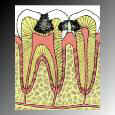Toothaches:
what causes them?
|
 |
The
decay penetrates the enamel (white) of the tooth and works it way
towards the pulp or nerve of the tooth (pink). |
A tooth ache is usually
caused when the nerve of the tooth becomes "irritated" by some form of
stimulus. Usually this stimulus is either in the form of decay that has invaded
the nerve, or trauma caused to the tooth.
How does decay affect the
tooth? The tooth is an actual living structure in your body. The nerve sits in
the middle of the tooth in an area called the pulp. this contains the nerve and
blood supply to the tooth. When you get a cavity, the bacteria that causes the
cavity starts to slowly eat away at the tooth working its way to the center of
the tooth and the nerve. Most of the time this process is painless and goes
unnoticed by the patient (Figure1). Sometimes
patients may feel sensitivity to cold foods and beverages as well as sweets such
as chocolate and candy. At this stage the cavity can usually be filled with the
appropriate filling material and the sensitivity goes away.
 |
The
decay has grown and is closer to the nerve. The patient may experience a
toothache with a cavity this size. |
If the cavity is left
untreated, the cavity will continue to grow and work its way to the center of
the tooth (Figure 2). During this time the patient may or may not feel any
symptoms. When a cavity becomes this large, the tooth is ideally treated with a
crown instead of a simple filling because of the extensive missing tooth
structure.
 |
The
decay has invaded the pulp of the tooth and an abscess is beginning to
form at the ends of the root. At this stage the tooth needs to be
treated with a root canal. |
If the decay reaches the
center of the pulp, then the pulp becomes infected (Figure 3). As the infection
grows, it puts pressure on the nerve of the tooth and this causes a tooth ache.
If the cavity reaches this stage, then a simple filling will not work. the nerve
of the tooth needs to be removed. this is called a root
canal.
Other times a tooth ache
may be caused not by the nerve of the tooth but because the gum tissue around
the tooth becomes infected. This infection called pericornitis
is a common reason that wisdom teeth are removed.
Visit your doctor to
determine the source of the toothache and what the appropriate treatment would
be.
| ![]()